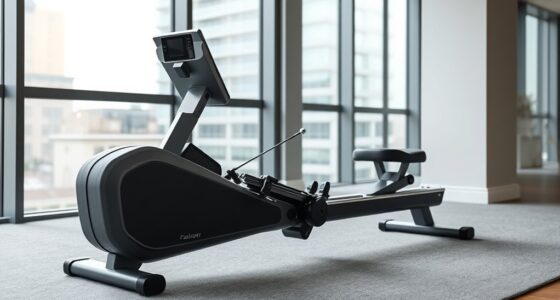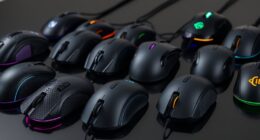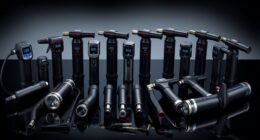If you’re looking for the 15 best edge AI development boards in 2025, I’ve found options that combine high performance, low power consumption, and versatility. These include advanced modules like the NVIDIA Jetson Orin Nano, Coral Dev Board, and compact boards like the WaveShare Luckfox Core3576. They support popular AI frameworks, offer robust connectivity, and are suitable for robotics, IoT, and industrial use. Stick around to discover all the top choices and how to pick the right one for your project.
Key Takeaways
- The list features top edge AI boards with high-performance processors, AI accelerators, and multi-modal capabilities for demanding applications.
- It covers a range of solutions including compact, industrial-grade, educational, and versatile development platforms.
- Compatibility with popular AI frameworks like TensorFlow, PyTorch, and TensorFlow Lite ensures flexible deployment.
- Connectivity options such as Wi-Fi 6, Bluetooth 5, and multiple I/O interfaces support seamless integration.
- Emphasis on energy efficiency, ruggedness, and user-friendliness caters to diverse industrial, IoT, and research needs.
Grove Vision AI Module V2 for Arduino and Raspberry Pi
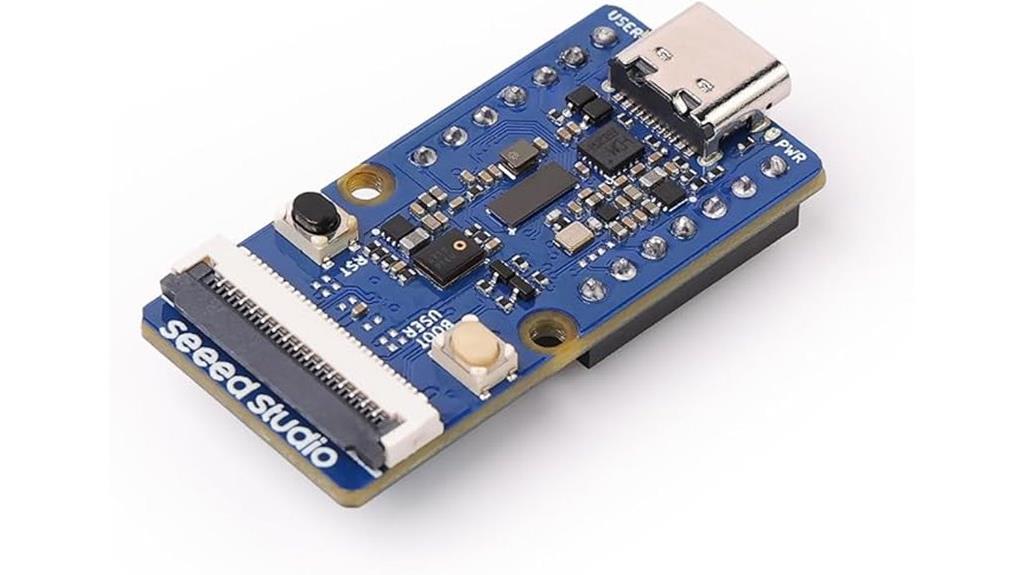
The Grove Vision AI Module V2 stands out as an ideal choice for developers seeking a versatile and high-performance edge AI solution for Arduino and Raspberry Pi projects. Powered by the Himax WiseEye2 HX6538 chip, it combines dual-core Arm Cortex-M55 and integrated neural network units for fast, efficient processing. Its support for popular AI models like MobileNet and YOLO, along with frameworks such as TensorFlow and PyTorch, makes deployment straightforward. Rich peripherals, including a PDM microphone and SD card slot, enhance its capabilities. Fully open source and compatible with multiple development environments, this module simplifies real-time AI applications in robotics, smart cameras, and IoT projects.
Best For: developers and hobbyists seeking a versatile, high-performance edge AI module compatible with Arduino and Raspberry Pi for robotics, smart cameras, and IoT applications.
Pros:
- Supports popular AI models like MobileNet and YOLO, enabling versatile vision applications.
- Rich peripherals including PDM microphone and SD card slot for expanded functionality.
- Fully open source with compatibility across multiple programming environments like Arduino, Micropython, and PlatformIO.
Cons:
- May require some technical expertise to optimize and integrate effectively.
- Slightly larger dimensions could be a consideration for ultra-compact projects.
- Limited detailed user reviews as of now, which might impact initial confidence in extensive real-world testing.
Youyeetoo CanMV-K230 AI Development Board (with 16GB TF Card)
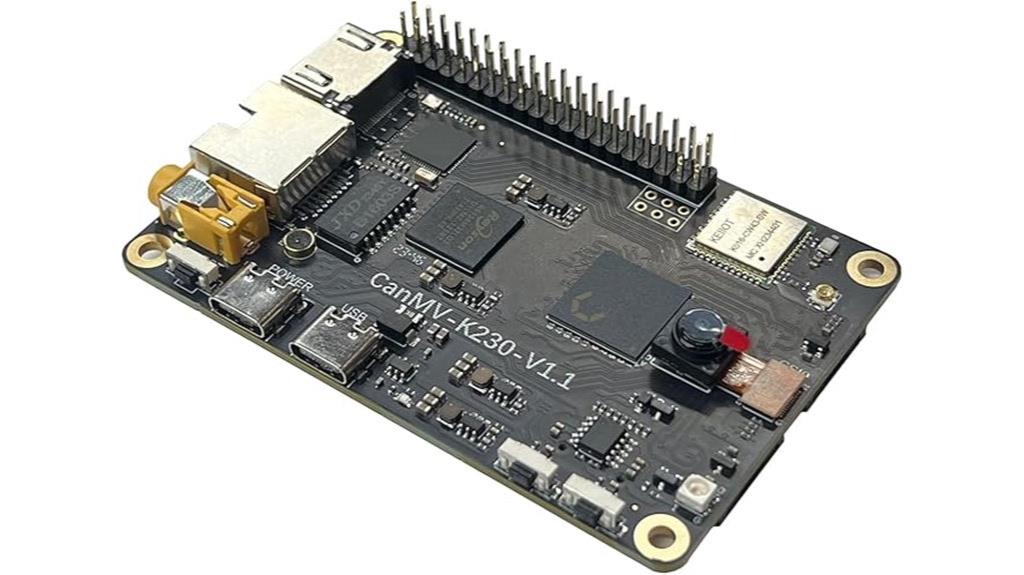
If you’re developing edge AI solutions that demand high-resolution vision and robust processing, the Youyeetoo CanMV-K230 AI Development Board with a 16GB TF card is an excellent choice. It’s compact, credit card-sized, and powered by the Kendryte K230 dual-core C908 RISC-V processor, offering 13.7 times the AI performance of K210. With support for three 4K HD cameras, Full HD processing, and 3D depth sensing, it handles advanced vision tasks effortlessly. The board supports multi-modal AI—vision, speech, OCR, translation—and comes with extensive SDKs, hardware schematics, and preloaded AI algorithms. It’s ideal for rapid development and deployment of powerful AI applications at the edge.
Best For: developers and engineers creating high-resolution, multi-modal AI edge applications requiring advanced vision, speech, OCR, and translation capabilities in a compact, powerful platform.
Pros:
- Exceptional AI performance with 13.7x speed increase over K210, suitable for demanding tasks
- Supports three 4K HD camera inputs and Full HD 3D depth sensing for advanced computer vision applications
- Comes with comprehensive SDKs, hardware schematics, and preloaded AI algorithms for rapid development
Cons:
- Slightly larger power consumption due to high-performance components and multiple camera support
- Limited RAM (512MB) may restrict very large or complex AI models on the device
- The compact size might pose challenges for integration into larger systems or custom enclosures
UNIHIKER AI Development Board with Silicone Case
Designed for learners and developers who prioritize durability and ease of use, the UNIHIKER AI Development Board with Silicone Case offers a robust solution for edge AI projects. It features a 2.8-inch color LCD touch screen supporting Python and visual programming, making it accessible for all skill levels. With WiFi and Bluetooth, plus extensive expansion interfaces, it’s highly versatile. The silicone case provides shock absorption and protection, ensuring durability during transport or intense use. Powered by a Linux OS on a DFROBOT processor with 4GB RAM, it’s quick to set up and ideal for IoT and educational applications, earning high user satisfaction.
Best For: learners and developers seeking a durable, easy-to-use edge AI development platform suitable for IoT, educational, and hobbyist projects.
Pros:
- Supports Python and visual programming for versatile coding options
- Built-in 2.8-inch color LCD touch screen enhances user interaction
- Robust silicone case provides shock absorption and durability during transport and use
Cons:
- Limited to 4GB RAM, which may restrict more complex applications
- Processor with a single core might impact performance for intensive tasks
- Availability and detailed support information are primarily through Amazon, which may limit direct access
CanMV K230 AI Development Board with K210 Camera Module
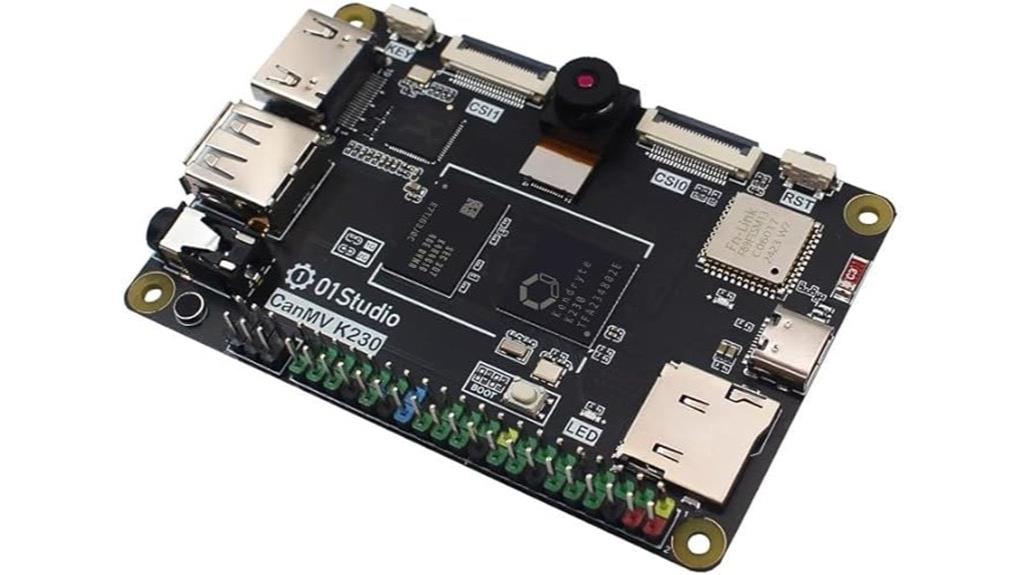
For developers seeking a compact yet powerful edge AI solution, the CanMV K230 AI Development Board with K210 Camera Module stands out. It’s built around Canaan’s K230 chip, offering 13.7 times the performance of K210, with support for three simultaneous 1080P/60FPS cameras. Its small size, about the size of a business card, makes it ideal for various vision applications. The board includes a 1G LPDDR4 RAM, HDMI output for easy debugging, and supports Python, enabling quick development of tasks like face recognition, barcode scanning, and object detection. Connectivity options include WiFi and serial interfaces, making it versatile for embedded AI projects.
Best For: AI developers and embedded system engineers seeking a compact, high-performance edge AI solution capable of multi-camera input and real-time image processing.
Pros:
- Significantly higher performance than K210, with 13.7x processing power, enabling complex AI applications.
- Supports three simultaneous 1080P/60FPS camera inputs, ideal for multi-view vision tasks.
- Compact size comparable to a business card, facilitating versatile deployment in various environments.
Cons:
- Limited to 1G LPDDR4 RAM, which may be insufficient for extremely large or complex AI models.
- Requires additional peripherals (e.g., external display, master controllers) for full functionality, increasing setup complexity.
- Price and availability may vary, potentially impacting budget-conscious or rapid deployment projects.
Luckfox Pico Mini B Linux AI Development Board (RV1103, ARM Cortex-A7, RISC-V MCU, NPU, 64MB DDR2, 128MB Flash)
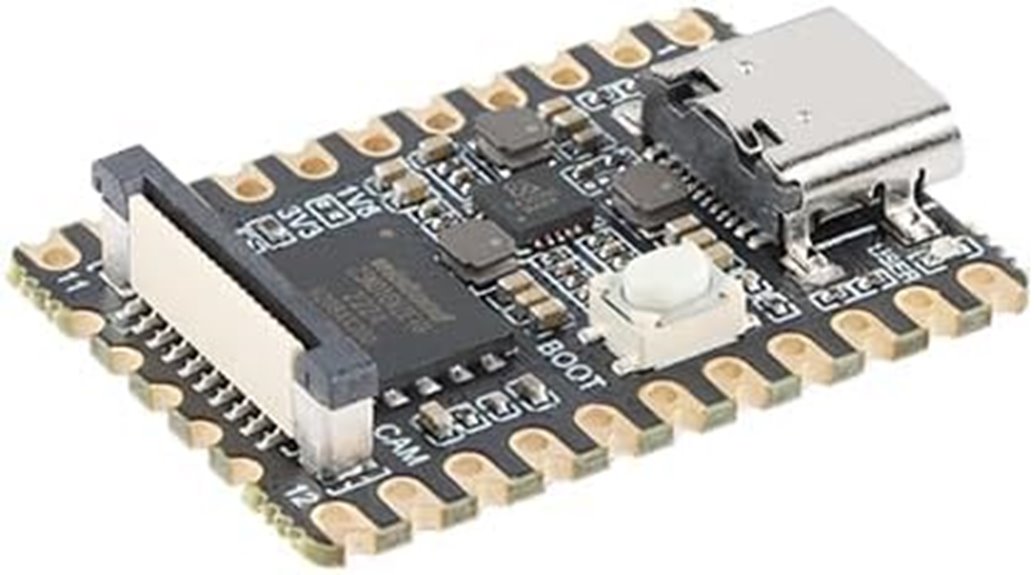
The Luckfox Pico Mini B stands out as an ideal choice for developers working on compact AI projects that demand quick deployment and efficient processing. Its small size, roughly 6.81 x 4.65 inches, makes it perfect for space-constrained applications. Powered by the RV1103 chip, it combines a dual-core ARM Cortex-A7 CPU with a RISC-V MCU, enabling fast startup and low power consumption. The onboard NPU supports mixed quantization, delivering up to 1 TOPS of AI inference power. With 64MB DDR2 RAM and 128MB Flash, it’s optimized for image processing, facial recognition, and embedded AI tasks. Its versatile interfaces ease integration into various projects.
Best For: embedded developers and AI enthusiasts seeking a compact, high-performance development board for quick deployment of AI inference and image processing applications.
Pros:
- Small size and lightweight design ideal for space-constrained projects
- Robust AI inference capabilities with up to 1 TOPS NPU and support for mixed quantization
- Versatile interfaces including camera input, USB, UART, SPI, and I2C for easy integration
Cons:
- Limited RAM (64MB DDR2) may restrict complex or large-scale AI models
- Storage capacity (128MB Flash) could be insufficient for extensive applications without external storage
- Requires familiarity with Linux and embedded system development for optimal use
Seeed Studio Realtek AMB82-Mini IoT AI Camera Board
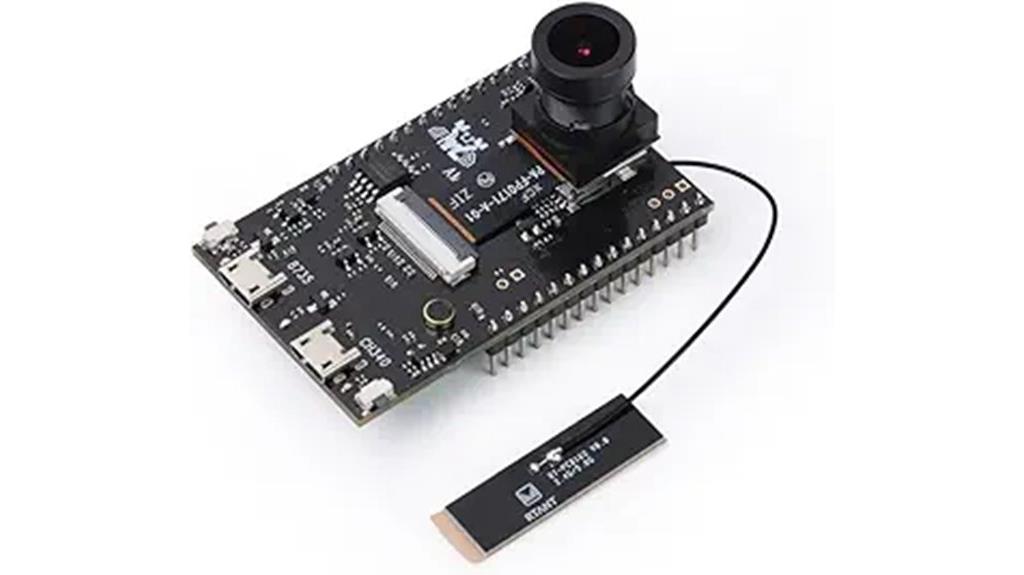
If you’re seeking an edge AI development board that excels in real-time video processing and low power consumption, the Seeed Studio Realtek AMB82-Mini IoT AI Camera Board is a compelling choice. It features a Realtek RTL8735BDM SoC with embedded AI, supporting 2K video, H.265/H.264/JPEG encoding, and TensorFlow-Lite AI. The board offers ultra-low power draw, fast boot times, and multiple stream support. Connectivity options include dual-band Wi-Fi, Bluetooth 5.1 BLE, and hardware security features. With a 1080p CMOS sensor, GPIOs, and various interfaces, it’s suitable for battery-powered IoT devices and network cameras, making it versatile for AIoT applications.
Best For: developers and hobbyists seeking an energy-efficient, high-performance AIoT camera platform for real-time video processing and edge AI applications.
Pros:
- Supports high-resolution 2K video with advanced encoding options (H.265/H.264/JPEG).
- Features embedded AI with a dedicated NPU capable of 0.4 TOPS, enabling efficient edge AI deployment.
- Ultra-low power consumption and fast boot times ideal for battery-powered IoT devices.
Cons:
- Limited official documentation and support, which may complicate setup and troubleshooting.
- Connectivity issues such as PC recognition and antenna loss reported by some users.
- SDK and firmware are not fully open or straightforward, requiring support requests for full access.
Seeed Studio XIAO ESP32C3 Microcontroller Board with Wi-Fi and BLE
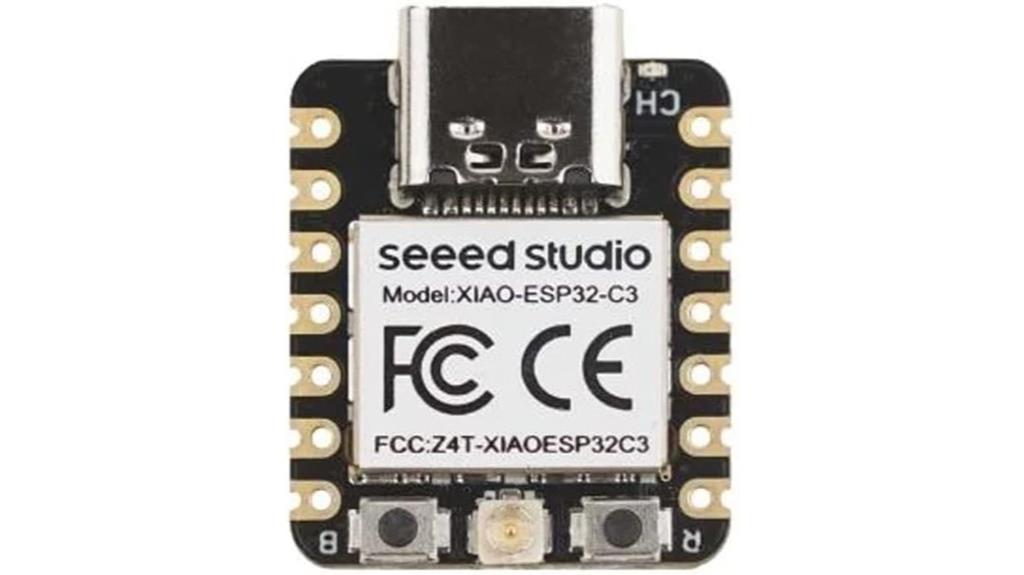
The Seeed Studio XIAO ESP32C3 Microcontroller Board stands out as an ideal choice for developers seeking compact, energy-efficient solutions for edge AI and IoT applications. Powered by the ESP32-C3 32-bit RISC-V chip running at 160MHz, it supports Arduino and CircuitPython, making development accessible. Its small form factor (21×17.5mm) with a breadboard-friendly layout ensures easy integration into wearables and compact devices. Equipped with a U.FL antenna for stable Wi-Fi and BLE 5.0, it offers long-range connectivity over 100 meters. Its ultra-low power modes, onboard battery charging, and multiple I/O options make it perfect for battery-powered, edge AI projects.
Best For: developers and hobbyists seeking a compact, energy-efficient microcontroller for edge AI, IoT, and wearable applications.
Pros:
- Supports multiple development environments including Arduino and CircuitPython for versatile programming.
- Compact size with SMD design makes it ideal for wearables and space-constrained projects.
- Long-range Wi-Fi and BLE connectivity with stable RF performance over 100 meters.
Cons:
- Limited analog input pins (4), which may restrict certain sensor integrations.
- Requires careful handling due to SMD components, making prototyping more challenging without proper tools.
- The small form factor may limit the addition of extensive peripherals or expansion modules.
USB Edge TPU ML Accelerator for Raspberry Pi and Single Board Computers

For developers seeking a compact, high-performance AI inference solution, the Google Coral USB Edge TPU ML Accelerator stands out as an ideal choice. It’s a small, powerful device that leverages Google’s Edge TPU ASIC to deliver rapid, energy-efficient ML inferencing on Raspberry Pi and other single-board computers. Capable of running models like MobileNet v2 at over 100 fps, it reduces CPU load and enables real-time object detection, smart security, and industrial AI tasks. Its plug-and-play design, USB 3.1 connection, and support for TensorFlow Lite make it easy to deploy, though some community support and setup challenges remain.
Best For: developers and hobbyists seeking a compact, energy-efficient AI inference accelerator for embedded systems, Raspberry Pi, and single-board computers to enable real-time object detection and smart AI applications.
Pros:
- High-speed, low-power ML inferencing with over 100 fps for models like MobileNet v2
- Plug-and-play USB 3.1 connection simplifies deployment on compatible devices
- Compact size and lightweight design ideal for embedded and industrial applications
Cons:
- Support repositories and documentation can be outdated or poorly maintained, complicating setup
- Limited onboard memory may affect performance with complex models or nighttime detection
- Higher demand and scalper pricing can make acquisition challenging and more expensive
Yahboom Jetson Orin Super Carrier Board AI Development Board

Designed for electronic mechanical engineers, the Yahboom Jetson Orin Super Carrier Board stands out as an ideal platform for developing advanced AI and embedded projects. It’s compatible with Jetson Orin Nano and NX modules, offering interface consistency and optimized electrical performance. Weighing just 4.2 ounces, it supports wide voltage input (9-19V DC) and features low power consumption. The board includes high-definition DP output, two M.2 slots for SSDs, and a slot for wireless cards. Its robust design offers reverse power protection and overcurrent safeguards, ensuring reliable operation. With Linux support and versatile connectivity, it’s a practical choice for innovative AI development.
Best For: electronic mechanical engineers and developers seeking a versatile, high-performance AI development platform compatible with Jetson Orin modules.
Pros:
- Interface consistency with official Jetson baseboards ensures easy integration.
- Supports multiple high-speed interfaces like DP and M.2 slots for SSDs and wireless cards.
- Robust design with reverse power and overcurrent protection for reliable operation.
Cons:
- First availability is scheduled for May 9, 2025, which may delay immediate access.
- Weighs only 4.2 ounces, potentially limiting some mechanical mounting options.
- Limited to specific Jetson Orin Nano and NX modules, requiring module compatibility checks.
RISC-V AI-IoT Development Board
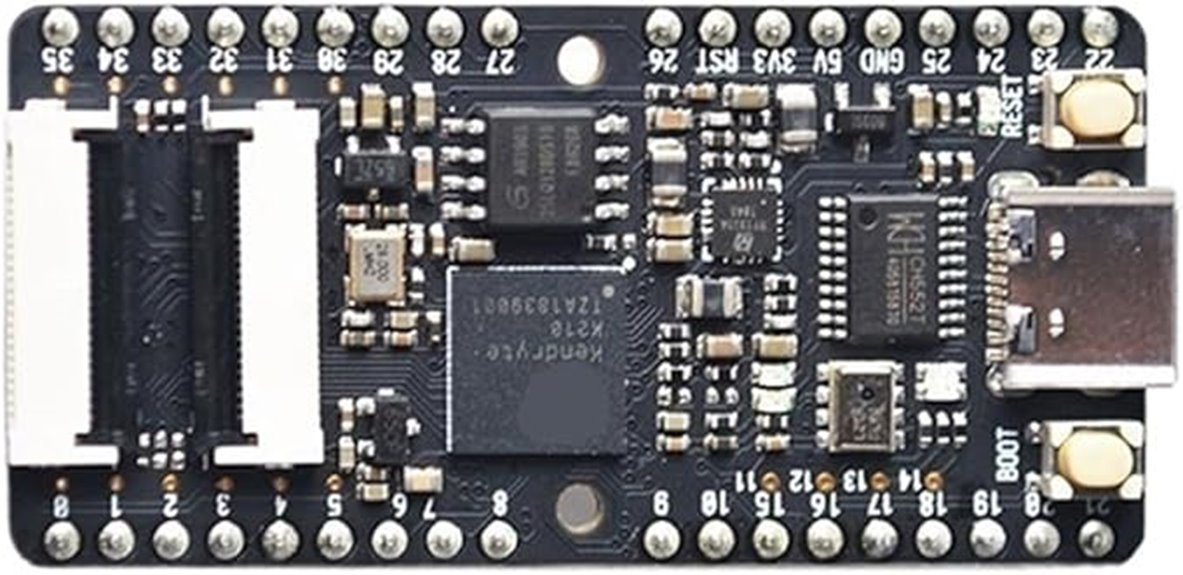
If you’re seeking a reliable edge computing solution tailored for industrial environments, the RISC-V AI-IoT Development Board stands out as a prime choice. It’s the first RV64-AI development board designed specifically for edge AI and IoT applications. Compact and robust, it weighs just 7.1 ounces and measures 1.18 x 0.79 x 0.39 inches, making installation straightforward. Built for durability and stability, it supports long-term operation in demanding settings. Designed by RCTCBRZVTW, it emphasizes easy maintenance and extended lifespan. This board is ideal for diverse industrial scenarios, offering reliable performance to power your AI and IoT projects at the edge.
Best For: industrial professionals and developers seeking a durable, compact edge computing solution for AI and IoT applications in demanding environments.
Pros:
- Designed specifically for edge AI and IoT, ensuring optimized performance for industrial scenarios
- Compact and lightweight, facilitating easy installation and integration
- Robust build quality supports reliable long-term operation and ease of maintenance
Cons:
- Limited technical specifications provided, which may require additional research for advanced features
- Pricing and shipping details are not included, potentially affecting purchase planning
- Marketplace policies and return fees may vary, adding complexity to post-purchase support
Sipeed Maix M1W Dock Kit K210 AI+IoT WiFi Development Board
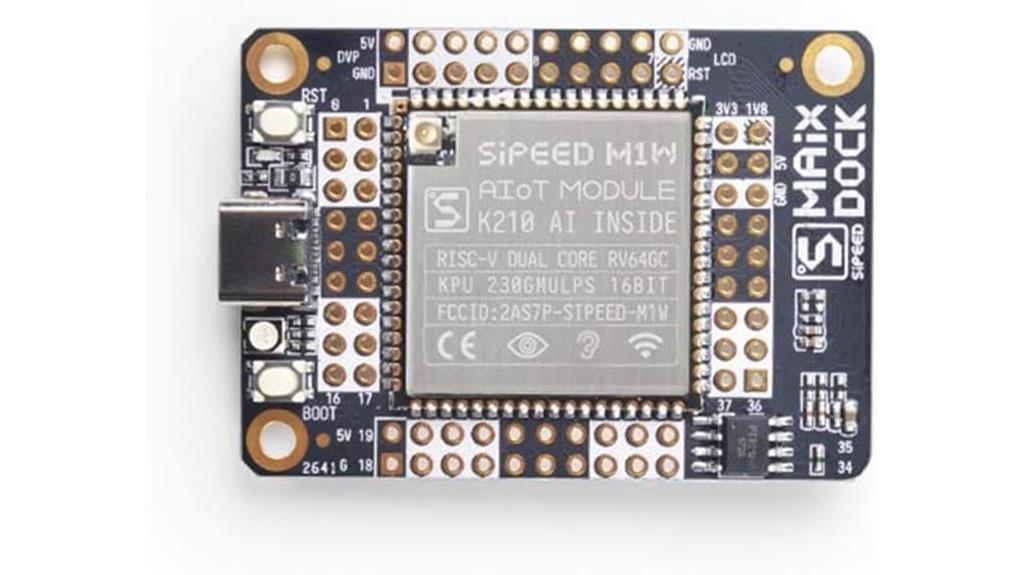
The Sipeed Maix M1W Dock Kit K210 stands out as an ideal choice for developers seeking a compact, high-performance edge AI solution that balances power and versatility. With a RISC-V dual-core 64-bit MCU running at 400-500MHz and up to 1 TOPS, it supports frameworks like TensorFlow and Keras, making AI tasks like face recognition, object detection, and voice recognition straightforward. Its onboard features include a camera, microphone, RGB LED, and multiple interfaces such as USB Type-C and DVP camera. Compatible with FreeRTOS and Arduino IDE, it’s perfect for rapid prototyping in IoT projects, smart devices, and robotics. Despite some documentation challenges, it offers a robust platform for edge AI deployment.
Best For: developers and engineers seeking a compact, high-performance edge AI platform for IoT applications, robotics, and smart devices.
Pros:
- Supports multiple AI frameworks like TensorFlow, Keras, Darknet, and Caffe for versatile development.
- Features onboard camera, microphone, and multiple interfaces, enabling rapid prototyping and integration.
- Compatible with popular development environments like Arduino IDE and PlatformIO, simplifying programming.
Cons:
- Documentation and setup guides can be limited or challenging for beginners.
- Proprietary AI detection files are locked behind paywalls, potentially increasing project costs.
- Customer reviews indicate some issues with user support and learning curve.
Coral Dev Board

The Coral Dev Board stands out for developers seeking a powerful, scalable platform for on-device machine learning prototyping, thanks to its integrated Edge TPU coprocessor capable of performing 4 TOPS efficiently. It combines a quad-core NXP i.MX 8M SoC with 4GB RAM, running Mendel Linux, making it easy to deploy familiar Linux tools. The board supports TensorFlow Lite and AutoML Vision Edge, streamlining model development and deployment. Its removable system-on-module (SoM) allows for easy scaling from prototype to production. With wireless connectivity, including Bluetooth, and a lightweight design, it’s an ideal choice for on-device AI projects that demand high performance and flexibility.
Best For: developers and engineers seeking a scalable, high-performance platform for rapid on-device machine learning prototyping and deployment.
Pros:
- Integrated Edge TPU coprocessor delivers high-speed ML inferencing at 4 TOPS with low power consumption.
- Supports familiar Linux tools via Mendel Linux, simplifying development workflows.
- Removable SoM allows for easy scaling from prototypes to large-scale production.
Cons:
- Slightly higher cost compared to simpler single-board computers without integrated ML accelerators.
- Limited to specific hardware and software ecosystem optimized for Google’s ML tools.
- May require technical expertise to fully utilize advanced ML capabilities and custom hardware integration.
Waveshare Luckfox Core3576 Edge Computing Development Board
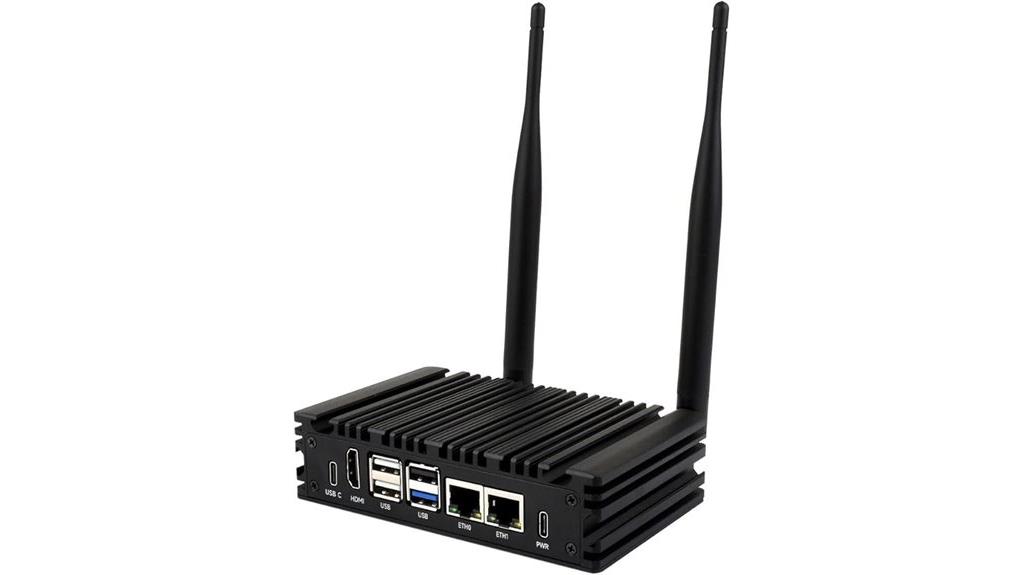
Designed for demanding edge AI applications, the Waveshare Luckfox Core3576 stands out with its robust Rockchip RK3576 octa-core processor, delivering both high performance and energy efficiency. It packs 8GB RAM and 64GB eMMC storage, housed in a protective case that aids heat dissipation. The board excels in AI vision tasks, supporting 4K video decoding at 120fps and encoding at 60fps, making it ideal for vision robotics, depth, and stereo vision. Multiple network interfaces enhance security and traffic management, while optional aluminum enclosures with fins provide passive cooling. With all-encompassing official support, the Core3576 balances power, efficiency, and durability for advanced edge AI deployments.
Best For: AI developers and vision robotics engineers seeking high-performance edge computing solutions with robust video processing and secure networking.
Pros:
- High-performance octa-core processor with energy-efficient design
- Supports 4K video decoding at 120fps and encoding at 60fps for advanced video tasks
- Multiple network interfaces enhance security and traffic management
Cons:
- May require additional cooling solutions for prolonged full load operation
- Limited storage capacity with 64GB eMMC, potentially needing external expansion
- Slightly bulkier enclosure options compared to compact boards
ESP32-P4 Smart Development Board with Touch Display
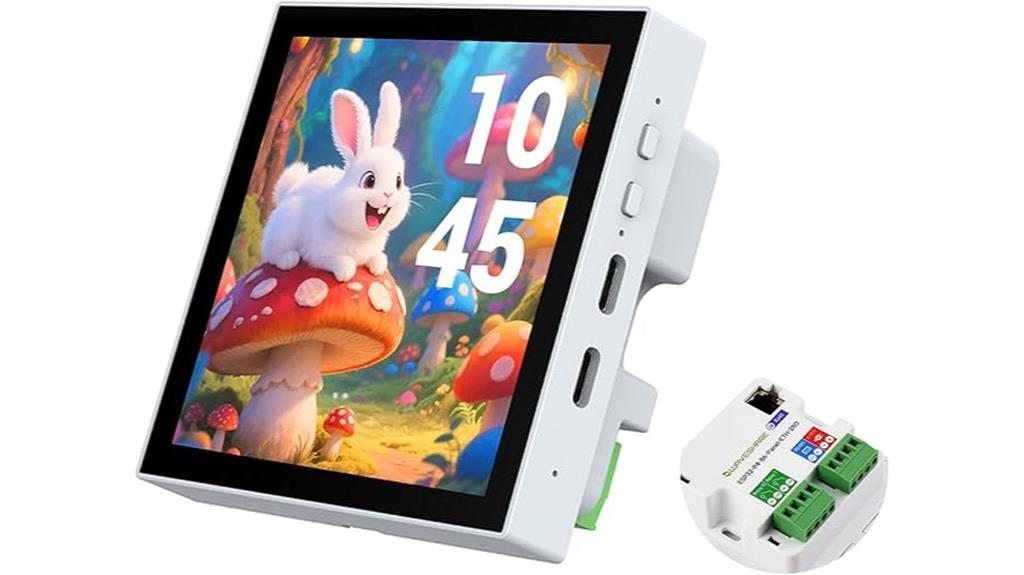
If you’re developing smart devices that demand intuitive interfaces and robust AI capabilities, the ESP32-P4 Smart Development Board with Touch Display stands out as an ideal choice. It features a powerful ESP32-P4 RISC-V dual-core processor, ample memory, and a bright 4-inch IPS touch screen supporting 5-point multi-touch. Connectivity is versatile, with Ethernet, Wi-Fi 6, and Bluetooth 5, plus multiple I/O options like USB, HDMI, and RS485. It excels in multimedia and AI tasks, supporting voice recognition, image processing, and secure data handling. Its compact design, combined with easy development support, makes it perfect for smart home and industrial applications.
Best For: DIY enthusiasts, developers, and industrial IoT professionals seeking a high-performance, secure, and easy-to-integrate smart development platform with advanced multimedia and AI capabilities.
Pros:
- Rich multimedia support including high-quality display, audio, and image processing features.
- Versatile connectivity options with Ethernet, Wi-Fi 6, Bluetooth 5, and multiple I/O interfaces.
- Built-in security features for reliable data protection and secure operations.
Cons:
- Slightly compact size may require careful handling during assembly.
- Advanced features might have a steep learning curve for beginners.
- Availability and pricing can vary, potentially affecting budget planning.
NVIDIA Jetson Orin Nano 8GB RAM Development Board Kit
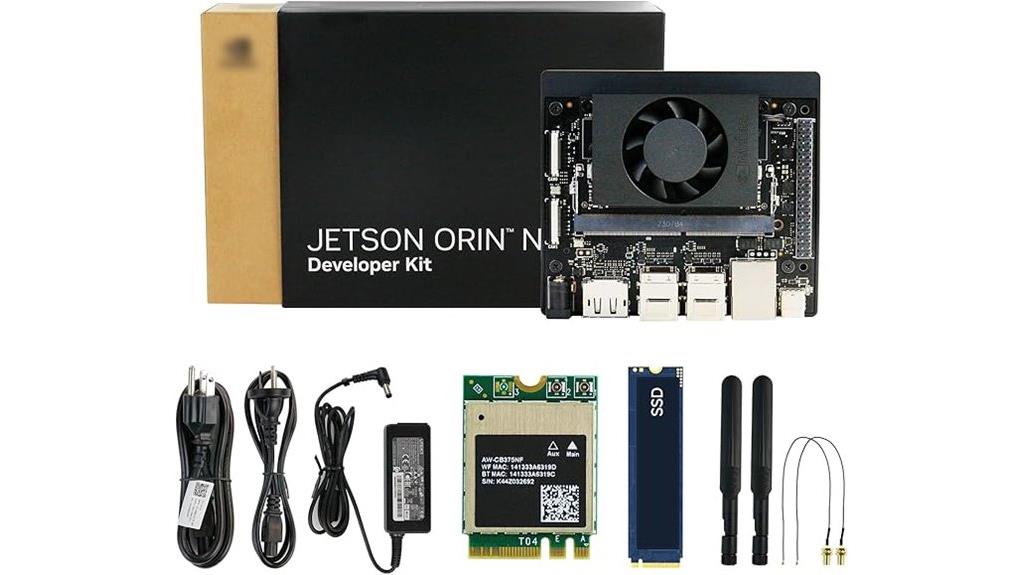
For developers seeking high AI performance in compact form factors, the NVIDIA Jetson Orin Nano 8GB RAM Development Board Kit stands out as an ideal choice. It offers 67 TOPS AI performance with a 1024-core NVIDIA Ampere GPU and 32 Tensor Cores, powered by a 6-core ARM Cortex-A78AE CPU. The board supports 8GB of LPDDR5 memory, external NVMe storage, and flexible power options like POE and adjustable modes. Running Ubuntu 22.04, it enables advanced AI vision, robotics, and environmental applications. Its stable design, extensive support, and multimodal AI capabilities make it perfect for deploying sophisticated edge AI solutions in a compact, efficient package.
Best For: developers and AI enthusiasts seeking a compact, high-performance edge computing solution for robotics, vision, and environmental applications.
Pros:
- Offers 67 TOPS AI performance with a powerful 1024-core GPU and Tensor Cores for advanced AI processing.
- Supports flexible power options including POE, adjustable modes, and external NVMe storage for versatile deployment.
- Runs Ubuntu 22.04 and provides extensive support for AI vision, robotics, and multimodal AI applications.
Cons:
- Customer reviews average only 3.7/5 stars, indicating mixed user experiences.
- Requires flashing a bootloader after receipt, which may be a technical hurdle for some users.
- Does not include a switch button, potentially complicating power management during setup.
Factors to Consider When Choosing Edge AI Development Boards
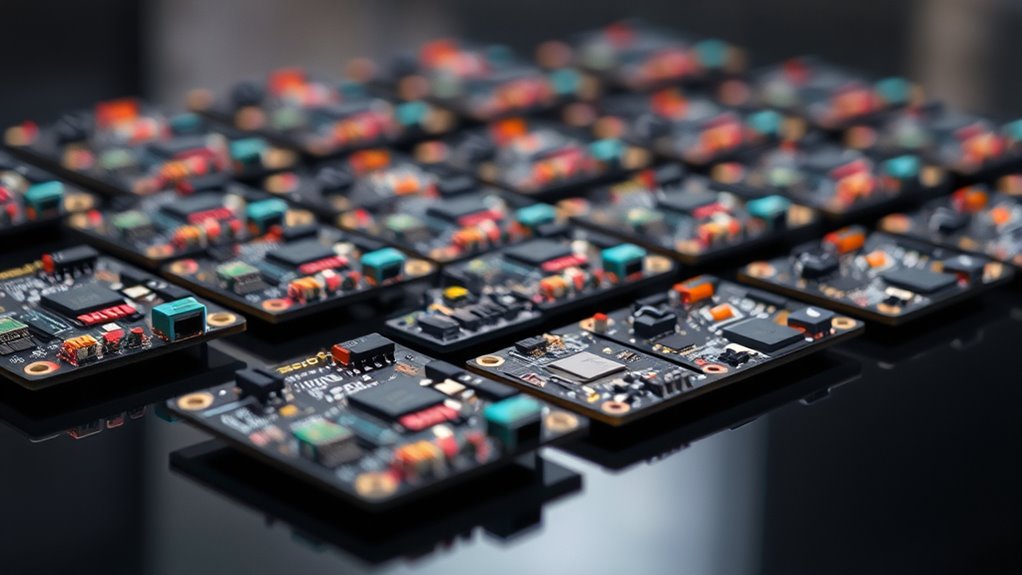
When selecting an edge AI development board, I focus on several key factors to guarantee it meets my project needs. I consider processing power, connectivity options, and power consumption to balance performance and efficiency. Additionally, I look at the ecosystem, compatibility, and size to make sure it integrates seamlessly into my setup.
Processing Power Requirements
Choosing the right Edge AI development board hinges on understanding your AI workload’s complexity and processing demands. I assess whether a single-core processor can handle your tasks or if multi-core CPUs or dedicated AI accelerators are necessary. Inference speed is critical—determine if real-time processing at specific frame rates or latency thresholds is required. I also check the supported AI models and frameworks to guarantee the processor’s computational capabilities match your deployment needs. Hardware acceleration units like DSPs, NPUs, or TPUs can dramatically boost performance, so I evaluate their availability. Finally, I balance processing power with power consumption constraints, ensuring high performance doesn’t compromise energy efficiency, especially for battery-powered or low-power applications. This careful assessment guides me to select an ideal board for my AI deployment.
Connectivity Options Available
Selecting the right Edge AI development board requires careful consideration of its connectivity options, as these determine how effectively it can communicate with other devices and networks. I look for boards with versatile options like Wi-Fi, Bluetooth, Ethernet, and cellular modules to ensure seamless data transfer and remote access. Many boards support multiple interfaces such as UART, I2C, SPI, and USB, making integration with peripherals straightforward. High-speed ports like USB 3.1 and HDMI are essential for rapid data transfer and high-resolution video output, critical for AI applications. Some boards also feature specialized connectivity like U.FL antennas for RF stability or MIPI-CSI for camera input, expanding their versatility. These options directly impact real-time processing capabilities, remote deployment, and IoT or industrial network integration.
Power Consumption Levels
Power consumption levels play a critical role in determining the suitability of an edge AI development board, especially for battery-powered applications. Low power consumption extends battery life and reduces cooling needs, making devices more efficient and sustainable. Boards with efficient processors, like ARM Cortex-M55 or RISC-V, typically use only a few milliwatts during operation. Power levels are usually specified in milliwatts (mW) or watts (W), with ultra-low-power boards operating below 1W. Choosing a board with optimized power management features, such as dynamic voltage scaling and sleep modes, can markedly cut energy use during idle periods. Striking the right balance between power consumption and processing capabilities ensures your device runs efficiently without sacrificing AI performance or functionality.
Ecosystem and Compatibility
When evaluating an edge AI development board, compatibility with development environments and interfaces greatly influences how smoothly you can integrate and program your project. Support for common platforms like Arduino, MicroPython, or Linux-based systems simplifies setup and coding. Standard interfaces such as CSI, USB, I2C, SPI, and UART ensure effortless connections to peripherals and sensors. A rich ecosystem—including SDKs, libraries, and community resources—reduces development time and troubleshooting efforts. Compatibility with popular AI frameworks like TensorFlow, PyTorch, or TensorFlow Lite allows for seamless deployment of models directly on the device. Additionally, a broad ecosystem enhances interoperability with hardware modules, cloud services, and accessories, making the system versatile and adaptable to evolving project needs.
Size and Form Factor
The size and form factor of an edge AI development board play a crucial role in determining how well it fits into your project’s space and design constraints. Smaller boards, like those around 21x17mm, are perfect for wearables or tightly packed environments, while larger boards offer more ports and expansion options for complex applications. The dimensions impact how easily the board integrates into enclosures, robots, or IoT devices, influencing installation and deployment flexibility. Lightweight and slim designs typically reduce power consumption and boost portability, essential for mobile or battery-powered setups. However, smaller boards also require careful thermal management to prevent overheating during intensive AI tasks. Choosing the right size ensures your project remains efficient, adaptable, and reliable within its physical limitations.
Frequently Asked Questions
Which Edge AI Board Offers the Best Power Efficiency for Portable Applications?
I believe the Raspberry Pi Zero 2 W stands out for portable applications because of its low power consumption and compact design. It’s perfect for projects where battery life matters most. I’ve found that it balances efficiency with enough processing power for many AI tasks. If you need something lightweight and power-efficient, this board is a great choice, making your portable AI deployment smoother and longer-lasting.
How Do Hardware Accelerators Impact AI Model Inference Speed?
Ever wonder how hardware accelerators speed up AI model inference? They substantially boost performance by offloading intensive computations from the CPU, allowing for faster processing. I’ve seen them cut inference times dramatically, making real-time AI applications feasible on edge devices. By optimizing matrix operations and parallel processing, these accelerators transform AI deployment—so, isn’t it essential to take into account them when aiming for quick, efficient AI performance?
What Are the Key Compatibility Considerations for Different AI Development Boards?
When choosing AI development boards, I focus on compatibility considerations like the supported hardware interfaces, operating systems, and software frameworks. I guarantee the board’s processor architecture matches my AI models and that it integrates smoothly with my sensors and peripherals. Compatibility with development tools and libraries is vital, too, so I verify that the board supports frameworks like TensorFlow or PyTorch. This guarantees a seamless deployment process.
How Scalable Are These Boards for Enterprise-Level AI Deployments?
These boards are quite scalable for enterprise-level AI deployments, especially when they support modular upgrades and high-speed connectivity. I find that choosing boards with robust processing power, ample memory, and flexible interfaces guarantees they can handle increasing workloads. Additionally, considering their compatibility with cloud platforms and ease of integration helps me expand deployments efficiently. Overall, the right edge AI board can grow with your enterprise needs, making scaling smooth and manageable.
What Security Features Are Integrated Into the Latest Edge AI Development Boards?
Imagine locking your most valuable treasures in a vault—that’s how I see the security features on these boards. They come with hardware encryption, secure boot, and tamper detection, making unauthorized access nearly impossible. I’ve seen these boards thwart attempts to breach data, giving me confidence in their security. They’re built like digital Fort Knox, ensuring your AI deployments stay safe and your data remains protected.
Conclusion
Just like a skilled conductor guiding an orchestra, choosing the right edge AI board harmonizes power and efficiency. Whether you envision a tiny sensor or a robust edge server, these boards are the brushstrokes shaping your AI masterpiece. Remember, the key is to find the perfect fit that transforms raw potential into seamless, intelligent performance—turning your ideas into a symphony of innovation at the edge.




